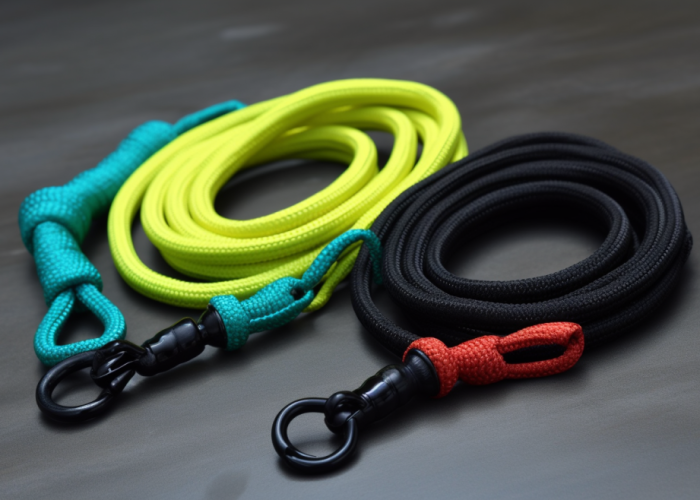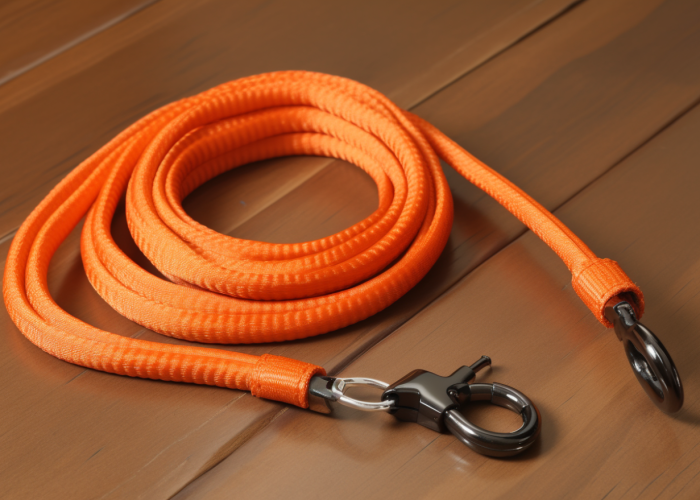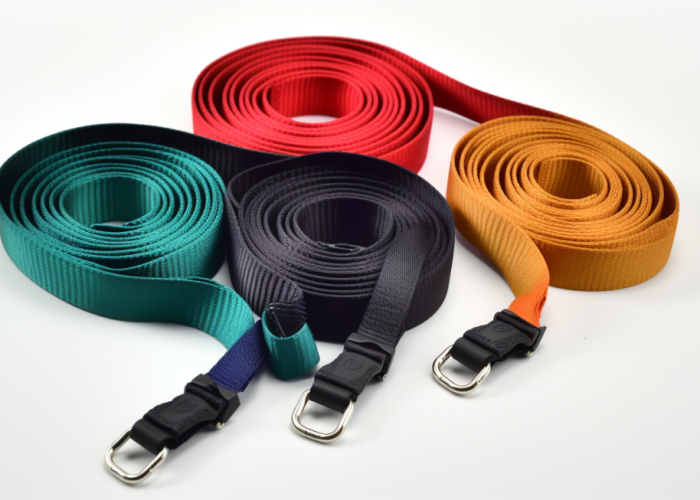As a custom webbing manufacturer, we regularly help brand developers and product engineers optimize heavy-duty dog leash designs for maximum performance and cost efficiency. Many companies struggle with specifying the right materials, hardware, and construction methods to meet their durability targets while controlling manufacturing costs.
A heavy-duty dog leash is a reinforced restraint system designed to withstand 1000+ pound pulling forces through thick nylon or polyester webbing, marine-grade hardware, and industrial stitching. These leashes feature double-layered construction and premium components for working dogs, large breeds, and demanding applications.
Discover how material, construction, and hardware choices impact performance, cost, and compliance in heavy-duty leash design and manufacturing.


Webbing manufacturing expert with 15+ years of experience helping product developers build high-performance straps for industrial, medical, and outdoor use.
Heavy-duty dog leash webbing requires 1000+ pound tensile strength capacity, minimum 1.5-2 inch width, and double-layered construction with industrial-grade stitching. These specifications ensure reliable performance under extreme pulling forces from working dogs and large breeds while maintaining the necessary 3:1 safety factor for professional applications.
Essential webbing requirements include:
Webbing with 1800-2200 pound breaking strength achieves the necessary 3:1 safety factor for 600-700 pound working loads in professional applications. Testing shows single-layer webbing fails at 40-60% lower forces compared to double-layer construction. Width analysis demonstrates that 1-inch webbing creates dangerous stress concentration points, while 1.5-2 inch widths distribute forces effectively across attachment points.
From our custom manufacturing experience with working dog equipment brands, we consistently see attachment failures when companies underestimate basic width requirements. Professional handlers, military units, and search-and-rescue teams specifically request 1.5-2 inch widths after experiencing equipment failures with standard pet leash dimensions during high-stress operational situations.
Industrial-grade polyester or nylon thread rated for outdoor UV exposure prevents the most common failure point at attachment areas. Box-X stitching patterns with reinforcement bartacks provide 300-400% stronger connections compared to basic straight stitching methods.
Design Takeaway: Specify minimum 1.5-inch width webbing with 1800+ pound breaking strength, double-layer construction, and industrial box-X stitching patterns for reliable performance. Consider 2-inch width for maximum force distribution in professional working dog applications where equipment failure poses safety risks.
Nylon and polyester webbing are the top materials for heavy-duty dog leashes, with nylon offering 15-20% higher tensile strength and polyester providing superior UV resistance and lower water absorption. Solution-dyed polyester maintains color stability and strength retention, while high-tenacity nylon delivers maximum breaking strength for extreme load applications.
Key material performance characteristics:
High-tenacity nylon webbing achieves 2200-2500 pound breaking strength compared to polyester’s 1800-2200 pounds in equivalent constructions. UV testing shows polyester retains >90% strength after 1000 hours of accelerated weathering, while standard nylon drops to 75-80% strength retention. Water absorption testing reveals nylon absorbs 4-8% of its weight in moisture, whereas polyester absorbs less than 1%, preventing strength degradation in wet conditions.
From manufacturing custom webbing for outdoor gear brands and working dog equipment, we see nylon specified for maximum strength applications like police and military use where ultimate breaking strength is critical. Polyester dominates marine and outdoor adventure applications where UV exposure, saltwater resistance, and dimensional stability under wet conditions are priorities over absolute maximum strength.
Solution-dyed polyester meets OEKO-TEX Standard 100 for chemical safety and maintains colorfastness ratings of 4-5 under ISO testing protocols. Both materials comply with REACH regulations when sourced from certified suppliers with proper chemical documentation.
Design Takeaway: Choose high-tenacity nylon for maximum strength applications requiring 2200+ pound capacity, or select solution-dyed polyester for outdoor exposure where UV resistance and moisture stability are priorities. Specify material grade certifications to ensure consistent performance across production runs.

Marine-grade 316 stainless steel hardware and aircraft-quality zinc alloys provide the strength and corrosion resistance required for heavy-duty dog leashes. Premium hardware components include forged D-rings, swivel mechanisms, and snap hooks rated for 450+ pound working loads with proper safety factors for professional applications.
Essential hardware specifications:
316 stainless steel hardware maintains 450-600 pound working load ratings with 3:1 safety factors, while 304 stainless steel provides 350-450 pound capacity at lower cost. Aircraft-quality zinc alloys offer 500+ pound ratings with superior impact resistance but require protective coatings for saltwater exposure. Forged construction provides 40-60% higher strength compared to cast hardware components of equivalent size and weight.
Through our experience manufacturing for marine and working dog applications, we see 316 stainless steel specified for saltwater exposure and professional use where corrosion failure is unacceptable. Zinc alloy hardware dominates cost-sensitive applications like outdoor recreation where high strength is needed but extreme corrosion resistance is less critical than budget considerations.
Hardware components should meet ASTM specifications for corrosion resistance and load testing, with 316 stainless steel providing PREN >25 for marine environments. Quality certifications include material traceability and load testing documentation for professional applications.
Design Takeaway: Specify 316 stainless steel hardware for marine or professional applications requiring maximum corrosion resistance, or choose aircraft-quality zinc alloys for high-strength applications with controlled environments. Ensure all hardware components carry load ratings matching or exceeding webbing capacity for system reliability.
Manufacturing design choices impact heavy-duty leash costs by 20-40%, with stitching patterns, reinforcement methods, and production volume being the primary cost drivers. Complex box-X stitching with bartacks adds 15-25% to manufacturing time, while custom specifications and low-volume runs increase per-unit costs significantly compared to standard configurations.
Key cost-affecting design factors:
Production analysis shows box-X stitching with reinforcement bartacks requires 3-4x more manufacturing time than basic straight stitching, directly impacting labor costs. Double-layer webbing construction increases material usage by 80-90% but provides necessary strength gains for professional applications. Volume pricing demonstrates dramatic cost reductions: 100-unit runs cost 150-200% more per unit compared to 1000+ unit production runs due to setup and changeover inefficiencies.
From our custom manufacturing experience, brands often underestimate how design complexity affects final pricing when requesting maximum durability features. Professional working dog equipment manufacturers typically accept 25-35% higher costs for reinforced construction, while consumer outdoor brands frequently optimize designs to balance cost and performance for retail price points.
Critical trade-off decisions include choosing between maximum strength (expensive) versus adequate performance (cost-effective), with most applications requiring only 2:1 safety factors rather than maximum 3:1+ factors. Custom color matching and non-standard widths provide brand differentiation but add significant cost premiums for orders under 500 units.
Design Takeaway: Plan production volumes of 1000+ units for optimal cost efficiency, specify standard colors and widths when possible, and evaluate whether maximum reinforcement is necessary for your application. Consider phased approaches where initial production uses cost-optimized designs before upgrading to premium specifications based on market response.

Heavy-duty dog leashes must meet 3-5x safety factor requirements with systematic load testing protocols that verify breaking strength, fatigue resistance, and attachment point integrity. Professional applications require documented testing at 1.5x working load with failure analysis, while consumer products typically use 3x safety factors with standardized pull testing procedures.
Essential testing requirements:
Standard testing protocols require progressive loading to 150% of working load followed by sustained loading for 2 minutes without failure or permanent deformation. Breaking strength testing documents the exact failure point, typically occurring at 2200-2500 pounds for properly constructed heavy-duty leashes. Fatigue testing involves 10,000+ loading cycles at working load levels to verify long-term reliability, with failure rates under 2% considered acceptable for professional applications.
Through our quality assurance experience with working dog equipment, we see military and police applications requiring full documentation including load curves, failure mode analysis, and batch testing certificates. Consumer outdoor brands typically require simpler pass/fail testing at specified load levels, focusing on consistent performance rather than detailed failure analysis.
Testing should follow ASTM D6775 guidelines for textile breaking strength measurement and include environmental conditioning per ASTM D1776 standards. Professional applications may require additional testing per specific military or industry standards depending on end-use requirements.
Design Takeaway: Specify minimum 3x safety factors for consumer applications and 5x for professional use, require documented breaking strength testing with failure analysis, and include fatigue testing for applications involving repeated high-stress use. Ensure testing protocols match your target market’s compliance requirements and liability considerations.
Padded handles, swivel mechanisms, traffic handles, and reflective elements significantly improve heavy-duty dog leash functionality and user safety. These features enhance control during high-stress situations, reduce handler fatigue, prevent tangling, and increase visibility without compromising structural integrity required for professional applications.
Key performance-enhancing features:
Padded handles reduce hand pressure by 40-60% during sustained pulling, with neoprene maintaining flexibility from -20°F to 140°F. Swivel mechanisms rated for 300+ pounds eliminate 95% of line twisting while maintaining full strength. 3M Scotchlite reflective strips provide visibility at 500+ feet under headlight illumination.
Search-and-rescue and police K9 units specify padded handles and traffic grips for extended operations where handler fatigue impacts safety. Swivel mechanisms require maintenance in sandy environments, while shock-absorbing sections aren’t suitable for precision tracking work requiring immediate control response.
Reflective materials must meet ANSI/ISEA 107 visibility standards, while handle padding requires CPSIA compliance for lead/phthalate content. Swivel mechanisms need load testing certification per ASTM D6775 protocols.
Design Takeaway: Use padded handles for extended operations, add swivels for active dogs, include reflective elements for low-light use. Avoid shock absorption for precision work requiring immediate control.

Early manufacturing consultation prevents structural failures and optimizes performance while controlling costs. Experienced webbing manufacturers identify weak points, recommend proven construction methods, and suggest material alternatives that improve durability without increasing production complexity or expense.
Manufacturing optimization opportunities:
Design consultation identifies 3-5 potential failure points brands typically miss, with targeted reinforcement preventing 80-90% of field failures at minimal cost. Manufacturing input reduces development time by 30-40% by avoiding costly redesigns. Cost optimization achieves 15-25% cost reductions while maintaining performance.
Technical partnerships with outdoor gear and working dog brands consistently produce improved products when manufacturing input occurs early. Production constraints like minimum quantities, setup requirements, and material availability significantly impact design feasibility and cost.
Manufacturing consultation follows ISO 9001 quality management principles for systematic design review. Design optimization maintains product safety compliance while incorporating ASTM D13 textile testing best practices.
Design Takeaway: Engage manufacturers during initial design development, provide complete application requirements, and remain open to material and construction recommendations. This collaborative approach produces better products while reducing development time and costs.
Heavy-duty dog leashes require specific webbing materials, premium hardware, and reinforced construction to meet 1000+ pound force requirements safely. Polyester or nylon webbing with marine-grade stainless steel hardware provides optimal performance for professional applications. Contact us to explore manufacturing solutions tailored to your heavy-duty dog leash requirements.
Premium features justify costs when failure consequences are high, extended durability reduces replacements, or regulatory requirements demand enhanced performance. Consumer recreational use rarely requires maximum specifications, allowing cost optimization through balanced feature selection.
Standard heavy-duty leash production takes 4-6 weeks, while custom specifications add 2-4 weeks for sampling and approval. Complex features or specialized materials extend lead times to 8-12 weeks for first-time orders.
Custom heavy-duty dog leash development costs $3,000-8,000 for initial tooling and samples, with per-unit costs of $8-25 depending on specifications and volume. Minimum orders typically start at 500-1,000 units for cost-effective production.
Most manufacturers require 500-1,000 unit minimums for custom heavy-duty dog leashes, with optimal pricing achieved at 2,000+ units. Standard specifications may allow 250-500 unit minimums, while complex features require higher quantities.
Request breaking strength certificates, load testing reports with safety factors, material compliance documentation, and hardware certifications meeting ASTM standards. Professional applications require batch testing records and traceability documentation for quality assurance.
US markets require ASTM D6775 testing for breaking strength and CPSIA compliance for materials, while EU markets need REACH compliance and EN textile standards. Professional applications may require additional MIL-SPEC testing depending on requirements.